Time to leave the fruit wine behind and carry on up the east coast of Scotland. Our next port of call is Broughty Castle in Dundee. The streets leading to the castle were incredibly narrow. We found a place to park on the side of a street, but weren’t sure how we were going to get turned around. Oh well, we’ll deal with it after our castle tour.
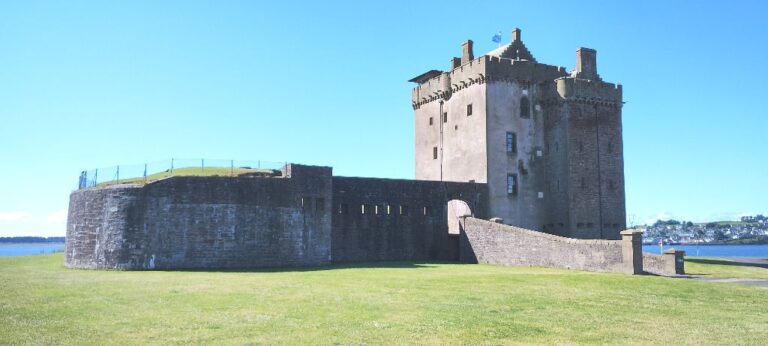
Broughty Castle sits on the River Tay (same river as the Stanley Mills we visited recently) and was completed in 1495 by the Scots. It was strategically important as it guarded the only water access to St. John’s Town (now Perth) where the Scone Palace was located. Scone Palace was the home of the Stone of Scone, or the Stone of Destiny as it was more commonly known. Common belief at the time held that no king had the right to reign over Scotland unless they had been crowned on the Stone of Destiny. Forty-two (42) Scottish kings have been crowned on the Stone of Destiny.
The English captured Broughty Castle in 1547, and the Scots (with the help of the French) recaptured the castle in 1550.
The English took the castle back in 1651, but it fell into ruin in the late 1600’s.
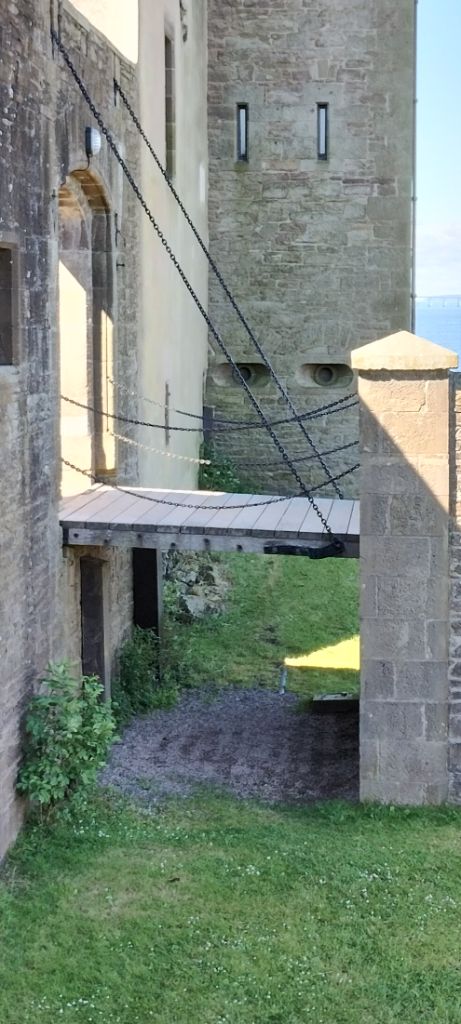
In 1846 the castle was purchased by the Edinburg and Northern Railway in order to build a harbour, for a railway ferry, on the property.
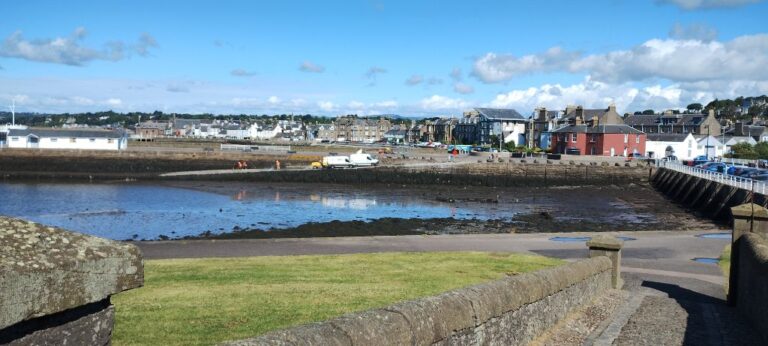
In 1855 the War Office purchased the castle with the intention of using it to defend against the Russians, but no work was actually done. In 1860 the War Office finally updated the castle and its artillery in response to fears of French invasion.
The castle was modified again in both World Wars in response to German threats.
To get out of Dundee we had to do a 52 point turn in a wee parking lot. No damage to Rosie or parked cars, so off we go. We are heading to Arbroath where we will spend the night.
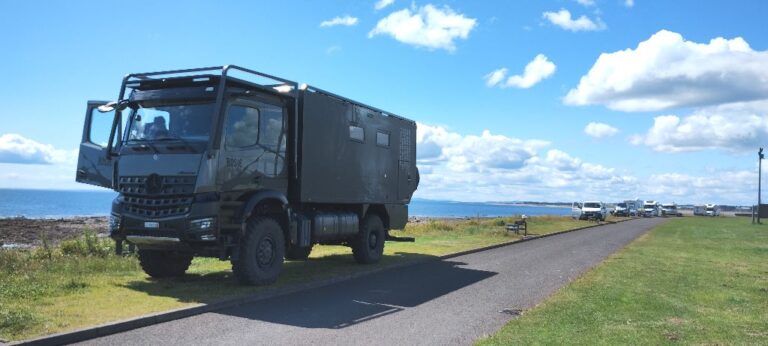
Arbroath is a nice mid-sized coastal town, with a busy little harbour. The harbour has an outer section, which seems to be mainly for small commercial fishing boats, and an inner harbour that held mostly pleasure craft. A gate, that looked like the type of gate we see in canal locks, separated the inner from the outer harbour.
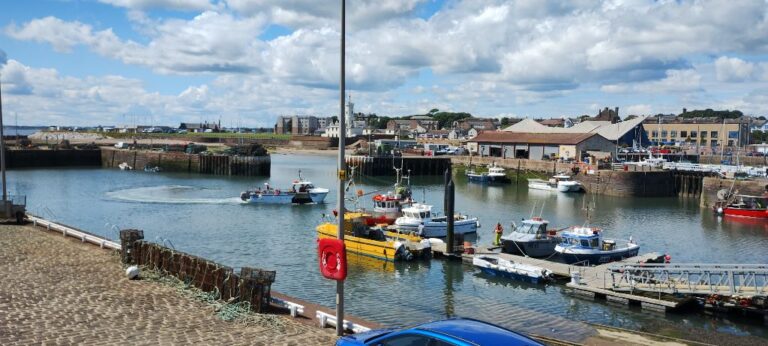
We took the dogs for a walk through the town of Abroath to see Arbroath Abbey, but when we got there we found it was all fenced off, with signs say “under restoration”. We followed the fencing around until we came upon a visitor centre for the Abbey which we were surprised to see was open. In yet another surprise, the Abbey was in fact open, you just had to go through the visitor centre to access it. So we quickly scooted through with the dogs.
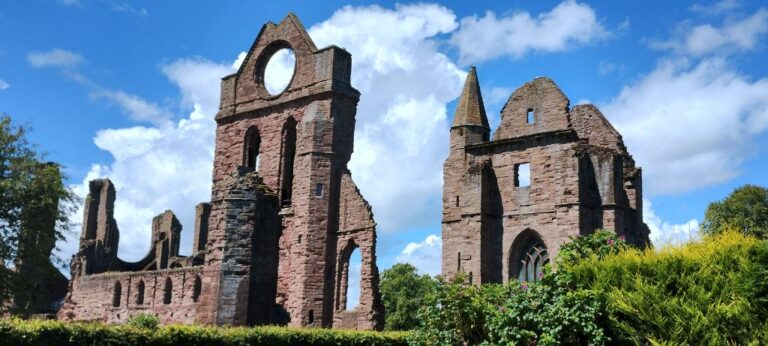
The Abbey was founded in 1178 by King William. King William generously endowed the abbey with income from 24 parishes, and allowed the Tironensian Monks to run a market and build a harbour. This doesn’t sound very monk-like, its more merchant-like. I wonder if the King got a cut of the proceeds? (probably).
Tironensian monks were also master craftsman and they actually built Abroath Abbey.
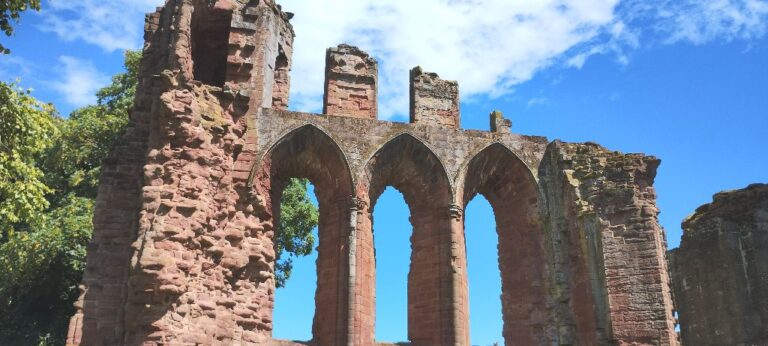
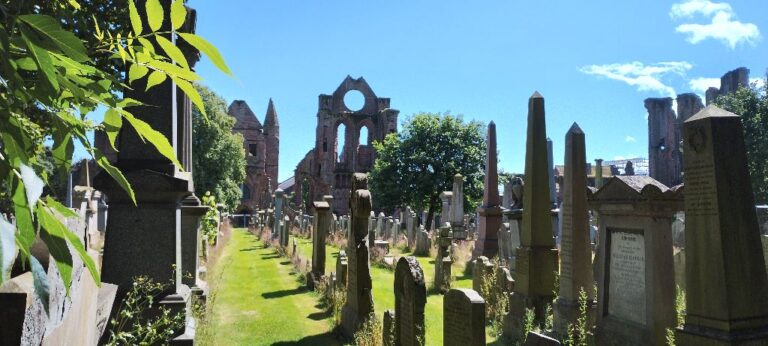
At its peak Abroath Abbey was the wealthiest Abbey in Scotland. King John of England gave the Abbey permission to buy and sell anywhere in England (except London) tax-free. This seems unusual for a couple reasons: (i) why would an English king get involved with a Scottish Abbey, and (ii) why would any king give up taxes? Who knows what leverage the Abbey used to gain concessions from the English nobility.
The Abbey is probably best know for being the location where the Declaration of Arbroath was created in 1320. This was a response to the Catholic Church’s excommunication of Scottish King Robert I and was written by Scottish barons. It is believed that this letter was penned by the Abbot of Arbroath. In the 1680’s this letter was translated from Latin, published in English and was sometimes referred to as the Scottish “declaration of independence”.
The Abbey fell into ruin after the Scottish Reformation (ca 1560), during which Scotland broke away from the Catholic Church and established the Protestant Church of Scotland.
There is an interesting connection between the Scone Palace, Westminster Abbey and Arbroath Abbey. During the Scottish Wars of Independence (1296-1329) the Stone of Destiny was taken by the English from Scone Palace and moved to Westminster Abbey. In December 1950 the Stone of Destiny went missing from Westminster Abbey. A group of students from the University of Glasgow had “liberated” the Stone from England. In April 1951 the Stone was found on the altar of the Abroath Abbey, and subsequently returned to Westminster Abbey (it was returned to Scotland in 1996 and can now be seen in Edinburgh Castle). No students were ever prosecuted for this adventure.
Just outside of Arbroath, in the village of Angus, is the St. Vigeans Sculptured Stones Museum. This museum contains a collection of 38 Pictish carved stones dating from the 9th century. We were interested in seeing the stones, so St. Vigeans is our next stop, or so we thought (ominous foreshadowing – dum dum dum dum).
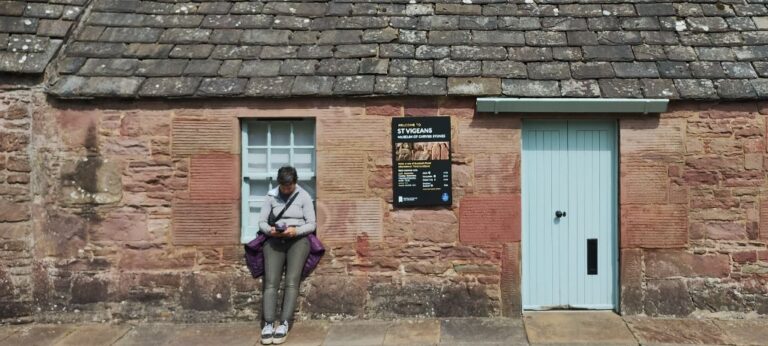
We checked yesterday to confirm the open hours of the museum, but when we arrived (during the aforementioned open hours) the door was locked. Subsequent checking of the museum website revealed a notice saying the museum is closed today. No Pictish stones for us. This seems to be a bit of a theme for us. We visited Houston Texas to tour the “Texas Battleship” (anchored in the Houston harbour), only to find out it had been moved for restoration (first time it moved in over 20 years). We went to Portsmouth harbour, during an earlier trip to England, to see Nelson’s ship the HMS Victory only to find that it was closed for restoration. Oh well.
Time to move on to our spot for the night.
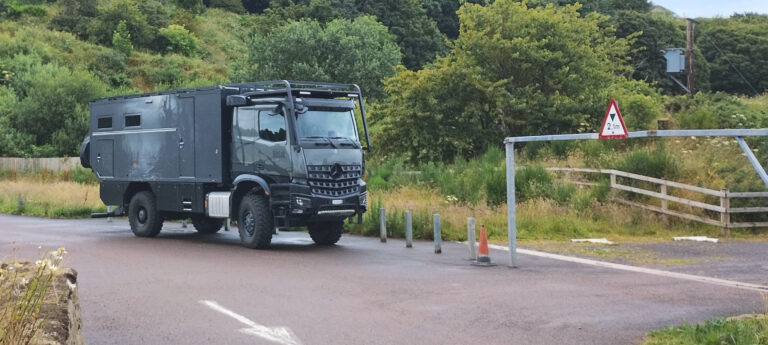
We didn’t have to get under the barrier as the Park staff let us stay in the bus parking area (right where we are in the photo above). There was also parking outside the access barrier for regular motorhomes, but these spots came with a rakish tilt (not conducive to cooking, and rolling out of bed at night and landing on the dogs is frowned upon by the dogs).
We are staying at the St. Cyrus Beach and Nature Reserve for a couple of nights. Initially, we only planned on staying here one night, but the weather forecast is calling for torrential rains and a weather advisory recommends people stay home (so we will stay put, in our home).
Not many people here, probably because of the weather, so we have the place almost to ourselves. The beach (see photo at top of this post) is almost deserted. This is a great sandy beach with dunes on one side.
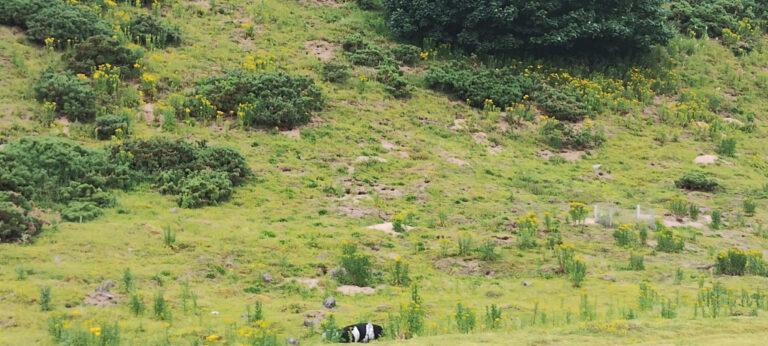
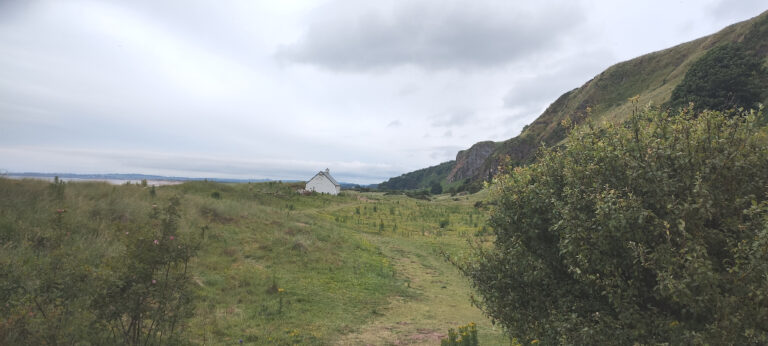
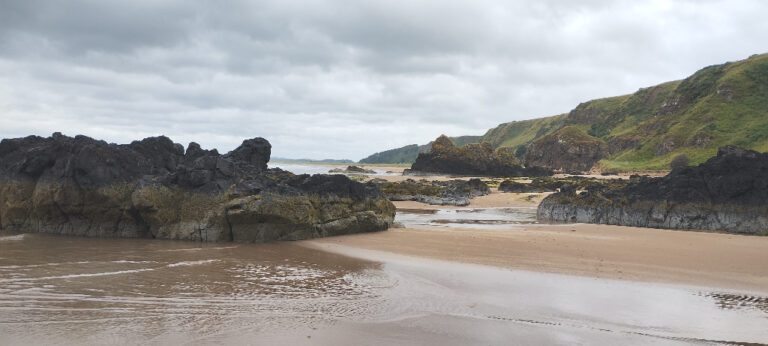
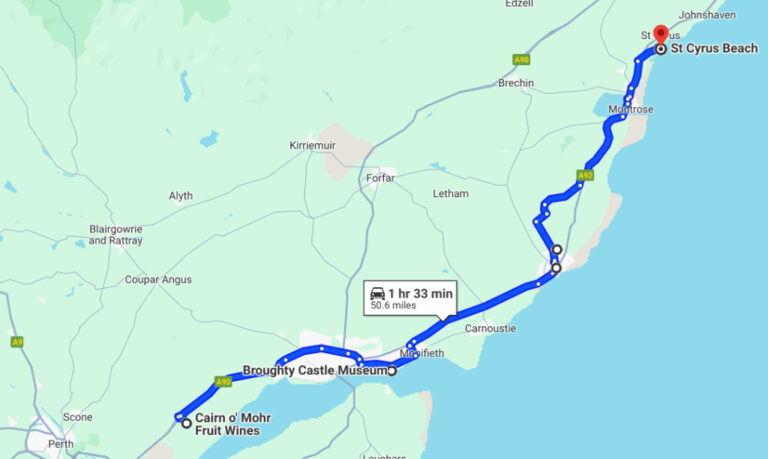

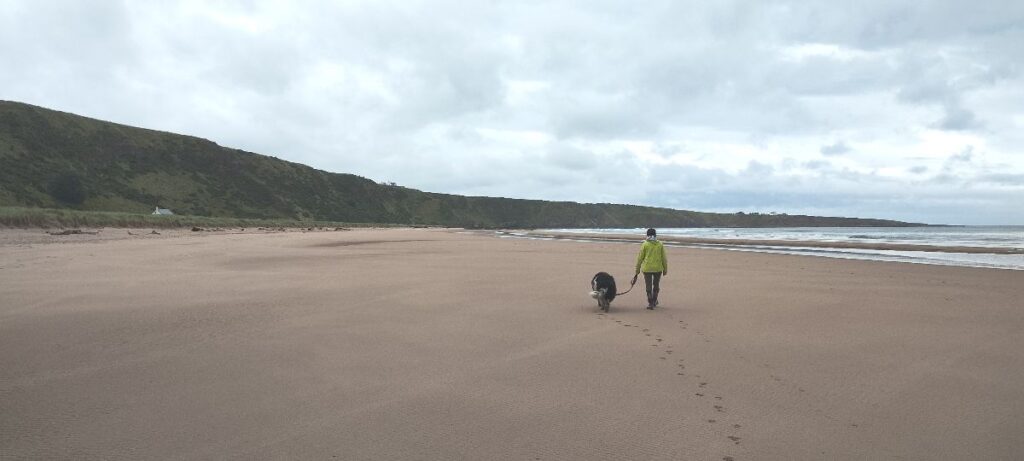
Your Dad sent along the link to your travels…. Stay safe and have fun.
Cousin Mark (southern California)
Good to hear from you!